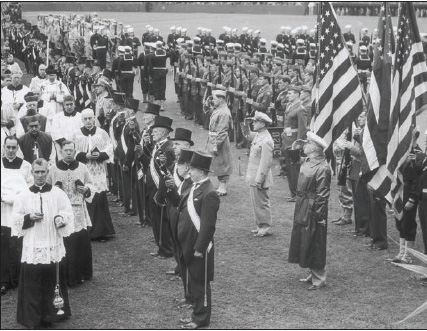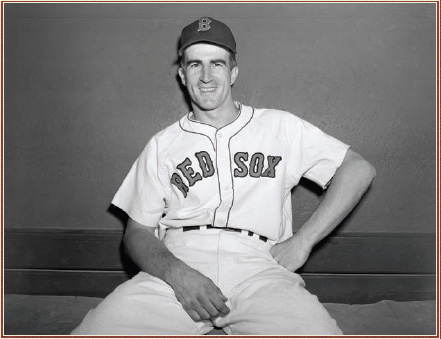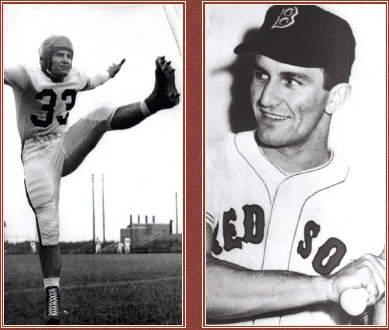Fenway Park (22 page)
Authors: John Powers
TED’S CLOUT; ALL-STAR ROUT
If he threw it today—when it could be shown endlessly on TV replays and dissected on the Internet—Pittsburgh Pirate Rip Sewell’s trick pitch would hardly rank as a novelty. But in 1946, Sewell’s “eephus” pitch, an exaggerated lob that made it look like it was shot out of a mortar, was known only to a limited number of baseball fans.
That was before Ted Williams gave the eephus lasting fame when he hit one of them into the home bullpen in Fenway Park during the 1946 All-Star Game, won by the American League, 12-0. The July 9 victory, before 34,906 fans, still stands as the most lopsided in All-Star Game history.
“Yes, that was my first look at the eephus or oophus or whatever you call it,” Williams said after putting on one of All-Star history’s most memorable batting shows, a performance that included a second home run, two singles, a walk, and five RBI.
“That’s the greatest exhibition of hitting I’ve ever seen,” said National League manager Charlie Grimm, whose 1946 squad had fewer hits (three—all singles) than Williams did.
The Red Sox, who would go on to win the 1946 pennant, placed eight players on that All-Star team. One of them was Johnny Pesky, who said Williams was not even in the batter’s box when he hit Sewell’s eephus.
“The first one Sewell threw was high,” Pesky recalled. “The crowd went ‘Oooooh.’ That pitch went up like 25, 30 feet in the air. Williams then moved up in the box, and the next one he hit it out of the park, but he was out of the batter’s box.”
Indeed, a front-page photo in the
Globe
shows that Williams’s right foot had crossed the white line marking the front of the batter’s box.
Sewell said he warned Williams in advance that he would throw the pitch to him.
“Before the game, Ted said to me, ‘Hey, Rip, you wouldn’t throw that damned crazy pitch in a game like this, would you?’” Sewell recalled afterward. “Sure, I said. I’m gonna throw it to you. So look out.”
Sewell actually threw three of the bloopers to Williams. On the first, Williams swung mightily and fouled it off the tip of his bat. A second blooper pitch was outside, and then came the third.
“It was a good one, dropping right down the chute for a strike,” Sewell said. “He took a couple of steps on it—which was the right way to attack that pitch, incidentally—and he hit it right out of there. And I mean he hit it.”
The ball landed in the American League bullpen.
“Well, the fans stood up and they went crazy,” Sewell recalled. “I told him, the only reason you hit it is because I told you it was coming. He was laughing all the way around the bases.”
Truett Banks “Rip” Sewell broke into the big leagues in 1932 and won 143 games before retiring in 1949. He would later say that Williams was the only batter ever to hit a home run off his eephus pitch.

Elaborate religious and military demonstrations brought crowds to the park in the 1940s.
When New York’s Joe DiMaggio later hit a homer to beat the Tigers, Boston earned its first pennant since 1918. By then, though, the players had dressed and scattered and Yawkey, who’d been lugging champagne around the Midwest for days and spent millions for one pennant, sent Tom Dowd, the club’s road secretary, around town for more than four hours to collect them.
Williams, who was visiting a dying veteran at an Army hospital, couldn’t be located and Pesky was hanging out with former Navy buddies. But everyone else came to Yawkey’s suite at the Hotel Statler to pop corks and toast what had appeared inevitable. “We ran away from ’em, didn’t we?” said Del Baker, a Sox coach. “That’s the best way to do it. Beat their brains out.”
So Boston, which had won 104 games and left its pursuers a dozen games behind, was favored to win the World Series over a St. Louis Cardinals club that survived a best-of-three pennant playoff against the Dodgers. “Why they’ve made the Red Sox such heavy favorites is beyond me,” Williams wrote in the
Globe
. “Those Cardinals have two arms and two legs like we have.”

MR. RED SOX, JOHNNY PESKY
BY BOB RYAN
Momma knew best. Johnny Pesky was ready to grab the cash—such as it was. He had been leaning toward Boston after Red Sox scout Ernie Johnson made his living-room sales pitch, but the St. Louis Cardinals moved in at the 11
th
hour and were offering a little more money than the $500 the Red Sox were discussing. It was 1939, Depression time. Any extra dollar would have meant a lot to the Paveskovich family of Portland, Oregon. But Maria Paveskovich did not want to hear it.
“She said, ‘No, no, no, Johnny,’” Pesky recalled. “‘I don’t care about the money. You go with Mr. Johnson. He will look out for you.’”
And thus was born a 70-plus-year relationship in which Pesky would be so closely associated with the ball club that his name would become attached to Fenway Park itself.
About that right-field foul pole. . . .
“[Sox pitcher] Mel Parnell started that,” Pesky explained. “I won a game with a home run down the right-field line against the Athletics. But I didn’t have any power, and I knew it.”
The pole is a mere 302 feet from home plate and Pesky recalled wrapping eight of his 17 career homers down the line and around it. It was officially named “Pesky’s Pole” in 2006. A lifetime .307 hitter, Pesky was a classic table-setter who led the American League in hits each of his first three seasons, a feat that has not been surpassed.
Pesky was an integral member of the Red Sox in those notable but frustrating post-World War II years between 1946 and 1950, when they won more games than any team in the league and only had one pennant to show for it.
“This is a game that can break your heart or build you to the heavens,” Pesky mused. “The Red Sox have not been a lucky club.”
Who better knows how cruel baseball fate can be than Johnny Pesky, who for so long was accused of “holding” the baseball on a relay throw from Leon Culberson while Enos Slaughter, running with the pitch, scored the winning run in Game 7 of the 1946 World Series?
He did, of course, no such thing. “Bobby Doerr defended me,” Pesky said. “Ted Williams defended me. Even Slaughter defended me.”
Johnny Pesky went away for a while. The Sox traded him in 1953 and he spent time managing in the Pittsburgh organization. But he always remained a Bostonian and now it’s as if those years away from the Red Sox never happened.
Pesky remains a viable member of the Red Sox family into his 90s, having served the club as a player, coach, manager, broadcaster, and general all-around goodwill ambassador. He was one of the first inductees into the Red Sox Hall of Fame in 1995. In 2008, the team retired his No. 6.


HARRY AGGANIS: A TWO-SPORT STAR
In life, Harry Agganis was the perfect model for the great American sports novel. In death, he was the ironic portrait of a Greek tragedy.
The son of poor immigrant parents from nearby Lynn, Massachusetts, Agganis had vaulted from the wrong side of the tracks to stardom, first as an All-American quarterback at Boston University and then as a .300-hitting first baseman for the hometown Red Sox. When he died suddenly at age 26 in 1955, the American sports scene was stunned and eulogies echoed around the world.
As George Sullivan wrote in a
Globe
retrospective in 1980, you had to have seen Harry Agganis to believe him. He was born Aristotle George Agganis. His mother called him “Ari” but his friends Americanized it to “Harry.” At the age of 14, Agganis played for a local semipro baseball team that often took on teams made up of servicemen, and he would routinely lace hits off major-league pitchers.
As a football player, Agganis led Lynn Classical High School to a 30-4-1 record in three seasons, including a national high school championship. He threw for 48 touchdowns and ran for 24 more, and more than 20,000 fans routinely filled the Lynn stadium to see Agganis play.
Frank Leahy, Notre Dame’s famed football coach, declared, “That boy is the greatest prospect I’ve ever seen,” and virtually every major college power in America recruited Agganis, to no avail.
He chose Boston University because he didn’t want to attend college away from his widowed mother. He went on to become an All-American player on both offense and defense, and in 1951, Paul Brown, the famed head coach of the Cleveland Browns, shocked the football world by making Agganis Cleveland’s No. 1 draft choice. Though Harry was only a junior and would not be able to play professionally for another year, Brown saw Agganis taking over for Otto Graham as his next star QB.
Crowds of 40,000 and more were common for games at Fenway Park when BU played college powers of the era. In Agganis’s sophomore season, he led the Terriers to six straight victories before they lost a 14-13 heartbreaker at Fenway to Maryland.
While playing at BU, Agganis was the subject of feature stories in Sport magazine and the
Saturday Evening Post
, yet he was so unselfish a player that his coaches had to order him to call more plays for himself.
When the Greek community in Lynn held a dinner in his honor, Agganis refused the money raised by the dinner. Instead, he sent it to the Greek village in Sparta where his father had been born to buy soccer balls and uniforms for youngsters there. In 1955, the Varsity Club of Boston gave him a new car, but again, Agganis refused the gift, using the money to bestow a scholarship at BU for Greek-Americans.
He ended up spurning football for a $40,000 bonus from the Red Sox (“I’ve already proved myself in football,” was his explanation) and, after a year with Boston’s top farm team in Louisville, he was the Red Sox starting first baseman in 1954.
Still a few credits shy of his BU degree, Agganis took courses during his rookie season. One memorable Sunday after getting three hits against the Tigers—including the game-winning home run—he rushed up Commonwealth Avenue to BU Field to receive his diploma at commencement. The June 7 headline in the
Globe
read: “Agganis the Hunter Bags Two Trophies: Tiger Hide, Sheepskin.”
Just a year later, in May 1955, Agganis was stricken by viral pneumonia and hospitalized for 10 days, but he rushed back into the lineup against doctor’s orders. In his last game with the Red Sox, Agganis batted cleanup behind Ted Williams at Chicago’s Comiskey Park and got two hits to boost his average to a team-leading .313.
He was stricken again on a train trip to Kansas City, and the severe infection was complicated by phlebitis. Just when he appeared to be recovering, he died suddenly of a massive pulmonary embolism at Sancta Maria Hospital in Cambridge on June 27. He was 26.
More than 25,000 paid their respects at St. George Greek Orthodox Church in Lynn. Every Greek Orthodox church in North and South America, more than 300 of them, held memorial services, an honor customarily reserved for Greek royalty and statesmen.
On a fall day in 1991, 36 years on, Agganis’ nephew, George Raimo, visited his grave in Lynn’s Pine Grove Cemetery and found a baseball placed there, with the simple inscription: “In everlasting respect.”
